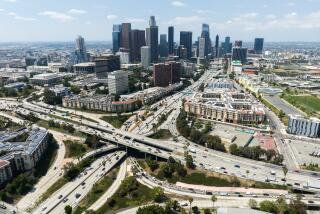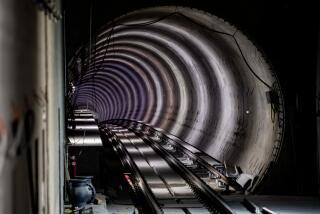Road Stays Rocky for Driverless Transit Cars : Green Line: Bradley advocates them but council heatedly rebuffs him. Panel also assails decision to buy vehicles from Japanese firm.
- Share via
Rebuffing Mayor Tom Bradley after a loud and heated exchange of words, the Los Angeles City Council voted Wednesday to ask county transportation commissioners to once again reconsider the use of driverless cars on the Metro Green Line.
The council also asked the Los Angeles County Transportation Commission to rethink its controversial decision to buy Japanese cars for that line--a decision that drew an emotional response in light of stubborn local unemployment.
The council’s vote came hours after nine congressmen said in an open letter to Commission Chairman Ray Grabinski that building the cars in Japan “may certainly create hardships” in Washington when Los Angeles seeks more federal transit funds.
However, local officials and Sumitomo Corp. of America planned secret talks to try to find a compromise in the controversy over the choice of the Japanese-owned company to build the 41 Green Line cars, sources said. Among the ideas: boosting the number of local jobs by using the losing American bidder, Morrison-Knudsen Corp., as a partner or major subcontractor.
The outlook for such discussions, if they occur, was unclear. Chuck White of Sumitomo said late Wednesday that “there have been no negotiations with M-K” and that at this time it would be impossible for the company to change its Green Line proposal.
Wednesday’s council votes came despite the commission’s assertion during an earlier meeting that only 79 local jobs separated the winning Sumitomo bid from the losing American proposal. That is a tiny fraction of the 19,000 jobs that the 23-mile, Norwalk-to-El Segundo Green Line project will create, commission members said.
Bradley, meanwhile, argued fruitlessly in a rare personal appearance before the council that driverless trains, although expensive, are the new world standard for mass transit and Los Angeles should not settle for “second than best.”
The mayor had been summoned before the council to explain his support for driverless cars. The council had unanimously recommended against that technology; a day later, the mayor, with the city’s two other representatives on the LACTC, voted in favor of it.
The City Council debate was hectic at times because it mixed two issues: driverless cars and the Japanese car builder. Both were approved by the LACTC, but not always by the same members. For example, Bradley vigorously argued for the costly driverless technology despite big budget overruns on the project, but he voted to have the cars built by the American firm, Morrison-Knudsen.
Councilman Zev Yaroslavsky, a longtime Bradley foe, tied the two issues together Wednesday, arguing that the mayor supported the American company, but his two personal appointees to the 11-member LACTC did not join him. Councilman Richard Alatorre voted for Sumitomo, while citizen representative James C. Tolbert abstained.
Bradley sputtered, shouted and tried to argue when Yaroslavsky called him “disingenuous” on the issue, contending that the mayor controls the votes of his appointees. But the mayor was cut off by Council President John Ferraro. In any case, Alatorre’s and Tolbert’s votes were not decisive.
Sumitomo was selected by the commission in December by a vote of 7 to 3. Voting with Bradley for the U.S. bidder were La Habra Heights City Councilwoman Judith Hathaway-Francis and Marv Holen, the alternate for Supervisor Ed Edelman.
The LACTC sought to stem debate over job losses by noting that building cars makes up a relatively small portion--about 370, or 2%--of all the jobs to be created in this country by the Green Line. The most jobs--about 14,600, or 77%--are being created by construction of track, yards and substations by domestic contractors.
Councilman Joel Wachs sparked a brief shouting match when he crashed the LACTC meeting with Yaroslavsky and criticized those numbers. He said they ignore the fact that hundreds of additional jobs would be created in this country if the cars were built here.
“You talk about the jobs that you are providing, but you aren’t talking about the jobs you aren’t providing!” he yelled at LACTC Chairman Grabinski before being ordered back to the Council Chamber by Ferraro.
Even between the companies competing to build the cars, the difference in the number of locally created jobs is small, said construction chief Ed McSpedon. Sumitomo plans to hire 370 people locally, while Morrison-Knudsen had offered to hire 449 county residents.
The two companies had a much larger difference when all U.S. jobs are compared. Sumitomo is planning to create a total of 1,750 U.S. jobs, both directly and through its subcontractors. Morrison-Knudsen, based in Idaho with a major plant in New York, planned to create 4,900 U.S. jobs.
Council members were skeptical of LACTC statements that there was little difference between the two proposals.
“When you throw a stone in a pond, it creates a ripple effect, the way jobs create other jobs in an area,” said Councilman Mike Hernandez. “Why we’re throwing this stone across the ocean and expecting it to create ripples here in Los Angeles is bothersome to me.”
Council members also worried that cost overruns to pay for the costly, computer-driven driverless technology may force LACTC to postpone or cancel other rail transit lines elsewhere in the county.
“It will work. It may cost more and take longer--everyone says that--but you’ll make it work,” Wachs said to LACTC Executive Director Neil Peterson during the council meeting. “But it will work at the expense of systems serving other parts of the city. It will come at the expense of the San Fernando Valley. It will come at the expense of East L.A.”
Yaroslavsky later asked Peterson and other LACTC staff members about their recommendations last year against the use of driverless trains. Peterson conceded that, “given the cost, (I thought) there would be a better way to go.” In voting to support driverless technology, the LACTC board overruled its staff.
“I think the people of this county deserve to know that in your opinion and in the opinion of five other members of the (LACTC) staff, this (driverless) system . . . should be junked,” Yaroslavsky said.
At their own news conference earlier, Peterson and McSpedon had said they will carry out the commission’s decision to build the system with driverless cars, despite their earlier reservations about the cost of that system.
One major reason for controversy over the selection of the driverless technology is that it will not match the technology that is being used on the Blue Line trolley and the Red Line subway, now under construction.
More to Read
Sign up for Essential California
The most important California stories and recommendations in your inbox every morning.
You may occasionally receive promotional content from the Los Angeles Times.










